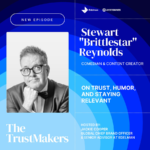By Justin Choi, Founder and CEO, Nativo
Depending on who you’re talking to in the ad industry, we’re either entering the Outcomes Era—or the Outcomes Era is already dead. Both sides miss the point.
This isn’t about whether outcomes matter. Of course they do. But focusing solely on outcomes without understanding what leads to them is a strategic failure. You don’t drive action without first earning consideration. And yet, that essential middle of the funnel—where opinions form and preferences shift—has been mostly ignored by the industry.
Outcomes Are Often Gamed, Not Earned
When outcomes become the only metric that matters, the industry stops thinking about persuasion and starts thinking about credit. That’s how we ended up with an entire ecosystem of intent thieves—players trying to insert themselves as close to the point of conversion as possible, just to claim attribution.
This approach rewards proximity over impact. It’s less about whether a message changed someone’s mind and more about whether a pixel fired at the right moment. That kind of thinking doesn’t build brands. It builds scavengers—one incentivized to take credit rather than create outcomes.
In the rush to prove performance, we’ve let the message itself fall by the wayside. And with it, we’ve lost one of advertising’s most essential functions: shaping opinion.
You Can’t Have an Outcome without First Being Considered
Consumers don’t wake up one day and buy something out of nowhere. The purchase is the final stop on a longer journey—one that usually includes conversations with friends, editorial reviews, social proof, comparison shopping, and more.
This is the consideration phase. And it’s where most brands lose visibility. Take travel, for example. A person thinking about a summer vacation doesn’t go straight from “I want a break” to booking flights. They chat with friends to hear about recent trips. They browse travel sites for ideas. They look up lists like “best places to visit in July” or “hidden gems in Canada.” They might spend days bouncing among YouTube videos, destination guides, TikToks, and Tripadvisor reviews—comparing hotels, reading up on things to do, checking prices, weighing how far their budget can stretch. At every step, they’re signaling intent and forming preferences. But unless a brand—say, a popular hotel chain—is present in those environments with relevant, helpful content, it’s missing the opportunity to transform awareness into action.
After all, for a lot of brands—especially in the Fortune 1000—awareness isn’t a challenge. These companies have been around for decades. Their names are known. The real challenge lies in staying part of the conversation once a potential customer starts considering their options.
While top-of-funnel awareness campaigns and bottom-of-funnel performance tactics are mature, optimized, and measurable, the middle of the funnel remains a black box. Brands invest billions trying to get people to pay attention or take action, but they often have no idea what happens in between.
That gap is a problem—and it’s where growth is leaking out.
The Mid-Funnel Is the Industry’s Choke Point
The ad industry has spent years refining tools for reach and tools for conversion. But tools for impact—especially impact on consumer thinking—are still scarce. Banner ads don’t change people’s minds—ever. The focus must be on engaging and persuasive content, as well as higher-impact formats.
That’s why so much of the conversation around outcomes rings hollow. If we can’t see or influence the part of the journey where decisions are actually being made, what are we really optimizing for?
We’ve got programmatic pipes that can deliver impressions to the “right person” in milliseconds. But how do we know we’re not delivering the wrong ad to that right person? If you ask marketers which content actually drives someone to consider their brands, most won’t have a clear answer. And that means their bottom-funnel efforts aren’t as effective as they could be.
If You Want Better Outcomes, Build a Better Middle
There’s nothing wrong with optimizing toward outcomes. But outcomes don’t appear out of thin air.
Marketers who want to drive real growth need to stop chasing intent and start shaping it. That means reclaiming the middle of the funnel—not as a vague concept, but as a measurable, targetable, and accountable part of the customer journey. After all, 71% of digital content consumers have said engaging and interesting content from a brand makes them trust that brand more.
We know that personalized brand storytelling effectively drives consideration. For example, Nativo content insights have found native articles deliver an average +5.4% lift in purchase consideration versus standard digital formats, with 1.3x more time spent with native articles than with traditional branded content. Likewise, multimedia content (e.g., video plus editorial) leads users to spend more time with content, indicating deeper engagement and information seeking (all key indicators of mid-funnel interest). Native video in particular generates 50% higher brand lift compared to pre-roll.
At the same time, shaping the mid-funnel also means holding media and technology partners to a higher bar. The same rigor we expect from performance channels needs to apply here.
The industry has figured out how to scale awareness. It has figured out how to capture conversions. Now, it needs to figure out how to drive consideration at scale.
Ultimately, declaring the Outcomes Era “over” is meaningless if we never understood what outcomes are built on in the first place. This isn’t about naming a new era. It’s about recognizing a longstanding oversight and finally doing something about it.
The future of brand growth depends on how well we illuminate, support, and activate the mid-funnel. That’s where minds are changed. That’s where momentum is built. Ignore it, and outcomes will always remain just out of reach.











